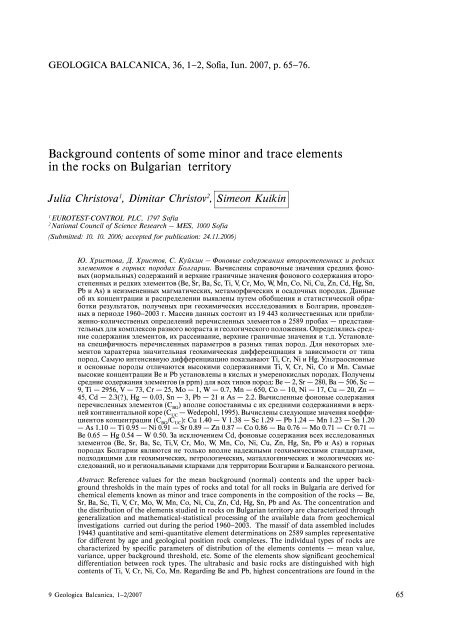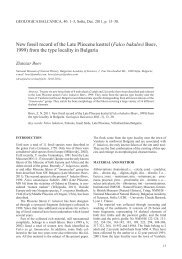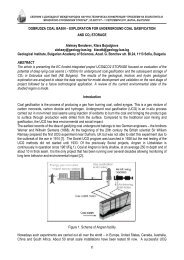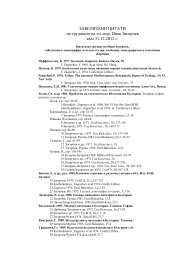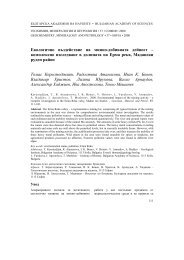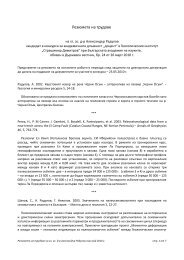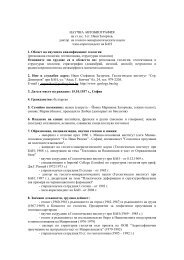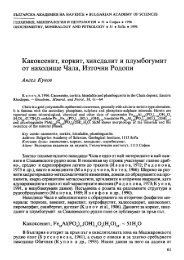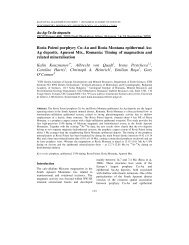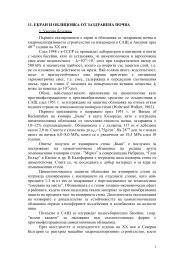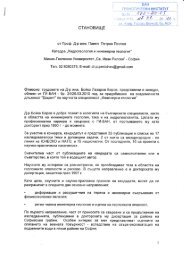Background contents of some minor and trace elements in the rocks ...
Background contents of some minor and trace elements in the rocks ...
Background contents of some minor and trace elements in the rocks ...
You also want an ePaper? Increase the reach of your titles
YUMPU automatically turns print PDFs into web optimized ePapers that Google loves.
GEOLOGICA BALCANICA, 36, 1—2, S<strong>of</strong>ia, Iun. 2007, p. 65—76.<strong>Background</strong> <strong>contents</strong> <strong>of</strong> <strong>some</strong> <strong>m<strong>in</strong>or</strong> <strong>and</strong> <strong>trace</strong> <strong>elements</strong><strong>in</strong> <strong>the</strong> <strong>rocks</strong> on Bulgarian territoryJulia Christova 1 , Dimitar Christov 2 , Simeon Kuik<strong>in</strong>1EUROTEST-CONTROL PLC, 1797 S<strong>of</strong>ia2National Council <strong>of</strong> Science Research – MES, 1000 S<strong>of</strong>ia(Submitted: 10. 10. 2006; accepted for publication: 24.11.2006)Þ. Õðèñòîâà, Ä. Õðèñòîâ, Ñ. Êóéêèí – Ôîíîâûå ñîäåðæàíèÿ âòîðîñòåïåííûõ è ðåäêèõýëåìåíòîâ â ãîðíûõ ïîðîäàõ Áîëãàðèè. Âû÷èñëåíû ñïðàâî÷íûå çíà÷åíèÿ ñðåäíèõ ôîíîâûõ(íîðìàëüíûõ) ñîäåðæàíèé è âåðõíèå ãðàíè÷íûå çíà÷åíèÿ ôîíîâîãî ñîäåðæàíèÿ âòîðîñòåïåííûõè ðåäêèõ ýëåìåíòîâ (Be, Sr, Ba, Sc, Ti, V, Cr, Mo, W, Mn, Co, Ni, Cu, Zn, Cd, Hg, Sn,Pb è As) â íåèçìåíåííûõ ìàãìàòè÷åñêèõ, ìåòàìîðôè÷åñêèõ è îñàäî÷íûõ ïîðîäàõ. Äàííûåîá èõ êîíöåíòðàöèè è ðàñïðåäåëåíèè âûÿâëåíû ïóòåì îáîáùåíèÿ è ñòàòèñòè÷åñêîé îáðàáîòêèðåçóëüòàòîâ, ïîëó÷åíûõ ïðè ãåîõèìè÷åñêèõ èñññëåäîâàíèÿõ â Áîëãàðèè, ïðîâåäåííûõâ ïåðèîäå 1960—2003 ã. Ìàññèâ äàííûõ ñîñòîèò èç 19 443 êîëè÷åñòâåííûõ èëè ïðèáëèæåííî-êîëè÷åñòâåíûõîïðåäåëåíèé ïåðå÷èñëåííûõ ýëåìåíòîâ â 2589 ïðîáàõ – ïðåäñòàâèòåëüíûõäëÿ êîìïëåêñîâ ðàçíîãî âîçðàñòà è ãåîëîãè÷åñêîãî ïîëîæåíèÿ. Îïðåäåëÿëèñü ñðåäíèåñîäåðæàíèÿ ýëåìåíòîâ, èõ ðàññåèâàíèå, âåðõíèå ãðàíè÷íûå çíà÷åíèÿ è ò.ä. Óñòàíîâëåíàñïåöèôè÷íîñòü ïåðå÷èñëåííûõ ïàðàìåòðîâ â ðàçíûõ òèïàõ ïîðîä. Äëÿ íåêîòîðûõ ýëåìåíòîâõàðàêòåðíà çíà÷èòåëüíàÿ ãåîõèìè÷åñêàÿ äèôôåðåíöèàöèÿ â çàâèñèìîñòè îò òèïàïîðîä. Ñàìóþ èíòåíñèâíóþ äèôôåðåíöèàöèþ ïîêàçûâàþò Ti, Cr, Ni è Hg. Óëüòðàîñíîâíûåè îñíîâíûå ïîðîäû îòëè÷àþòñÿ âûñîêèìè ñîäåðæàíèÿìè Ti, V, Cr, Ni, Co è Mn. Ñàìûåâûñîêèå êîíöåíòðàöèè Be è Pb óñòàíîâëåíû â êèñëûõ è óìåðåíîêèñëûõ ïîðîäàõ. Ïîëó÷åíûñðåäíèå ñîäåðæàíèÿ ýëåìåíòîâ (â ppm) äëÿ âñåõ òèïîâ ïîðîä: Be – 2, Sr – 280, Ba – 506, Sc –9, Ti – 2956, V – 73, Cr – 25, Mo – 1, W – 0.7, Mn – 650, Co – 10, Ni – 17, Cu – 20, Zn –45, Cd – 2.3(?), Hg – 0.03, Sn – 3, Pb – 21 è As – 2.2. Âû÷èñëåííûå ôîíîâûå ñîäåðæàíèÿïåðå÷èñëåííûõ ýëåìåíòîâ (C BG) âïîëíå ñîïîñòàâèìû ñ èõ ñðåäíèìè ñîäåðæàíèÿìè â âåðõíåéêîíòèíåíòàëüíîé êîðå (C UC– Wedepohl, 1995). Âû÷èñëåíû ñëåäóþùèå çíà÷åíèÿ êîåôôèöèåíòîâêîíöåíòðàöèè (C BG/C UC): Cu 1.40 – V 1.38 – Sc 1.29 – Pb 1.24 – Mn 1.23 – Sn 1.20– As 1.10 – Ti 0.95 – Ni 0.91 – Sr 0.89 – Zn 0.87 – Co 0.86 – Ba 0.76 – Mo 0.71 – Cr 0.71 –Be 0.65 – Hg 0.54 – W 0.50. Çà èñêëþ÷åíèåì Cd, ôîíîâûå ñîäåðæàíèÿ âñåõ èññëåäîâàííûõýëåìåíòîâ (Be, Sr, Ba, Sc, Ti,V, Cr, Mo, W, Mn, Co, Ni, Cu, Zn, Hg, Sn, Pb è As) â ãîðíûõïîðîäàõ Áîëãàðèè ÿâëÿþòñÿ íå òîëüêî âïîëíå íàäåæíûìè ãåîõèìè÷åñêèìè ñòàíäàðòàìè,ïîäõîäÿùèìè äëÿ ãåîõèìè÷åñêèõ, ïåòðîëîãè÷åñêèõ, ìàòàëëîãåíè÷åñêèõ è ýêîëîãè÷åñêèõ èññëåäîâàíèé,íî è ðåãèîíàëüíûìè êëàðêàìè äëÿ òåððèòîðèè Áîëãàðèè è Áàëêàíñêîãî ðåãèîíà.Abstract: Reference values for <strong>the</strong> mean background (normal) <strong>contents</strong> <strong>and</strong> <strong>the</strong> upper backgroundthresholds <strong>in</strong> <strong>the</strong> ma<strong>in</strong> types <strong>of</strong> <strong>rocks</strong> <strong>and</strong> total for all <strong>rocks</strong> <strong>in</strong> Bulgaria are derived forchemical <strong>elements</strong> known as <strong>m<strong>in</strong>or</strong> <strong>and</strong> <strong>trace</strong> components <strong>in</strong> <strong>the</strong> composition <strong>of</strong> <strong>the</strong> <strong>rocks</strong> – Be,Sr, Ba, Sc, Ti, V, Cr, Mo, W, Mn, Co, Ni, Cu, Zn, Cd, Hg, Sn, Pb <strong>and</strong> As. The concentration <strong>and</strong><strong>the</strong> distribution <strong>of</strong> <strong>the</strong> <strong>elements</strong> studied <strong>in</strong> <strong>rocks</strong> on Bulgarian territory are characterized throughgeneralization <strong>and</strong> ma<strong>the</strong>matical-statistical process<strong>in</strong>g <strong>of</strong> <strong>the</strong> available data from geochemical<strong>in</strong>vestigations carried out dur<strong>in</strong>g <strong>the</strong> period 1960—2003. The massif <strong>of</strong> data assembled <strong>in</strong>cludes19443 quantitative <strong>and</strong> semi-quantitative element determ<strong>in</strong>ations on 2589 samples representativefor different by age <strong>and</strong> geological position rock complexes. The <strong>in</strong>dividual types <strong>of</strong> <strong>rocks</strong> arecharacterized by specific parameters <strong>of</strong> distribution <strong>of</strong> <strong>the</strong> <strong>elements</strong> <strong>contents</strong> – mean value,variance, upper background threshold, etc. Some <strong>of</strong> <strong>the</strong> <strong>elements</strong> show significant geochemicaldifferentiation between rock types. The ultrabasic <strong>and</strong> basic <strong>rocks</strong> are dist<strong>in</strong>guished with high<strong>contents</strong> <strong>of</strong> Ti, V, Cr, Ni, Co, Mn. Regard<strong>in</strong>g Be <strong>and</strong> Pb, highest concentrations are found <strong>in</strong> <strong>the</strong>9 Geologica Balcanica, 1—2/200765
acid <strong>and</strong> moderate acid <strong>rocks</strong>. Most <strong>in</strong>tensively differentiated by rock types are <strong>the</strong> <strong>contents</strong> <strong>of</strong>Ti, Cr, Ni, Hg. The mean <strong>contents</strong> derived for all <strong>rocks</strong> on Bulgarian territory are <strong>the</strong> follow<strong>in</strong>g(<strong>in</strong> ppm): Be – 2, Sr – 280, Ba – 506, Sc – 9, Ti – 2956, V – 73, Cr – 25, Mo – 1, W – 0.7, Mn– 650, Co – 10, Ni – 17, Cu – 20, Zn – 45, Cd – 2.3(?), Hg – 0.03, Sn – 3, Pb – 21 <strong>and</strong> As –2.2. The background <strong>contents</strong> obta<strong>in</strong>ed for <strong>the</strong> <strong>elements</strong> studied (C BG) show good co<strong>in</strong>cidencewith <strong>the</strong> respective recent averages for <strong>the</strong> upper cont<strong>in</strong>ental crust (C UC) calculated by Wedepohl(1995). The coefficients <strong>of</strong> concentration (C BG/C UC) are: Cu 1.40 – V 1.38 – Sc 1.29 – Pb 1.24 –Mn 1.23 – Sn 1.20 – As 1.10 – Ti 0.95 – Ni 0.91 – Sr 0.89 – Zn 0.87 – Co 0.86 – Ba 0.76 –Mo 0.71 – Cr 0.71 – Be 0.65 – Hg 0.54 – W 0.50. The reference values obta<strong>in</strong>ed for <strong>the</strong>background <strong>contents</strong> <strong>of</strong> Be, Sr, Ba, Sc, Ti, V, Cr, Mo, W, Mn, Co, Ni, Cu, Zn, Hg, Sn, Pb <strong>and</strong> As(Cd excluded) could be accepted as sufficiently reliable st<strong>and</strong>ards for comparative geochemical,petrological, metallogenic <strong>and</strong> ecologic <strong>in</strong>vestigations <strong>and</strong> as regional Clarkes <strong>of</strong> <strong>the</strong>se <strong>elements</strong>for <strong>the</strong> Bulgarian territory <strong>and</strong> <strong>the</strong> Balkan region.Christova, J., Christov, D., Kuik<strong>in</strong>, S. 2007. <strong>Background</strong> <strong>contents</strong> <strong>of</strong> <strong>some</strong> <strong>m<strong>in</strong>or</strong> <strong>and</strong> <strong>trace</strong><strong>elements</strong> <strong>in</strong> <strong>the</strong> <strong>rocks</strong> on Bulgarian territory. – Geologica Balc., 36, 1—2; 65—76.Key words: <strong>m<strong>in</strong>or</strong> <strong>and</strong> <strong>trace</strong> <strong>elements</strong> <strong>in</strong> <strong>rocks</strong>, background <strong>contents</strong>, regional Clarkes.IntroductionUnderst<strong>and</strong><strong>in</strong>g <strong>of</strong> <strong>the</strong> background element <strong>contents</strong>is based on Vernadskiy’s law: <strong>the</strong> chemical <strong>elements</strong>are spread <strong>and</strong> dispersed comparatively uniformly<strong>and</strong> ubiquitously <strong>in</strong> <strong>the</strong> Earth crust; <strong>the</strong> dispersedspread<strong>in</strong>g is a normal <strong>and</strong> common state <strong>of</strong> existence<strong>of</strong> <strong>the</strong> <strong>elements</strong> (Âåðíàäñêèé, 1954). All types<strong>of</strong> natural formations (<strong>rocks</strong>, soils, water, air, plants,etc.) are characterized by <strong>the</strong>ir own comparativelystable element content’s levels which are consideredas background ones.The background <strong>contents</strong> <strong>of</strong> <strong>the</strong> chemical <strong>elements</strong><strong>in</strong> <strong>the</strong> <strong>rocks</strong> may be assessed as <strong>the</strong> follow<strong>in</strong>g referencevalues: (a) global values, also known as “Clarkes”(Darnley, 1995; Îâ÷èííèêîâ, 1990) – determ<strong>in</strong>edfor <strong>the</strong> Earth crust <strong>and</strong>/or its layers; (b) regionalvalues (regional Clarkes) – obta<strong>in</strong>ed for considerablylarge territories; (c) local geochemical background– characteristic for limited, restricted areas,l<strong>and</strong>scapes, etc. Reference values for backgroundconcentrations <strong>of</strong> <strong>the</strong> <strong>elements</strong> can be obta<strong>in</strong>ed bygeneraliz<strong>in</strong>g <strong>in</strong> a given hierarchical level, elaborat<strong>in</strong>g<strong>and</strong> <strong>in</strong>terpret<strong>in</strong>g <strong>the</strong> available analytical data on<strong>the</strong> element <strong>contents</strong>.On <strong>the</strong> <strong>the</strong>oretical basis cited above one <strong>of</strong> <strong>the</strong>most significant results <strong>of</strong> <strong>the</strong> geochemical <strong>in</strong>vestigationscarried out dur<strong>in</strong>g <strong>the</strong> 20-th century is <strong>the</strong>derivation <strong>of</strong> geochemical st<strong>and</strong>ards – referencevalues for <strong>the</strong> mean element <strong>contents</strong> (Clarkes) <strong>in</strong><strong>the</strong> ma<strong>in</strong> types <strong>of</strong> <strong>rocks</strong> <strong>and</strong> <strong>in</strong> general for <strong>the</strong> Earthcrust, only for <strong>the</strong> cont<strong>in</strong>ental crust, for its upper<strong>and</strong> lower layers, etc. – Turekian & Wedepohl (1961),Âèíîãðàäîâ (1962), Îâ÷èííèêîâ (1990), ßðîøåâñêèé(1990), Wedepohl (1995), Rudnick & Gao(2003) <strong>and</strong> o<strong>the</strong>rs. These studies concern ma<strong>in</strong>ly <strong>the</strong>upper cont<strong>in</strong>ental crust which represents 31.7% <strong>of</strong><strong>the</strong> Earth crust exposed on <strong>the</strong> surface <strong>and</strong> accessiblefor <strong>in</strong>vestigations. At <strong>the</strong> same time similar assessmentshave been obta<strong>in</strong>ed also for <strong>some</strong> <strong>in</strong>dividualregions <strong>and</strong> countries, for example, for Australia,Canada, F<strong>in</strong>l<strong>and</strong>, Germany, Great Brita<strong>in</strong>, India,Portugal, Russia, USA, etc. (cited <strong>in</strong> Wedepohl,1995 <strong>and</strong> Rudnick & Gao, 2003), for Ch<strong>in</strong>a (Gao etal., 1998; Tong, 1995), Central Kazakhstan (Ãëóõàí,Ñåðûõ, 2000) <strong>and</strong> o<strong>the</strong>rs.The geochemical problem for <strong>the</strong> element backgroundconcentrations <strong>in</strong> <strong>the</strong> <strong>rocks</strong> was elaborated<strong>in</strong> Bulgaria <strong>in</strong> <strong>the</strong> 60-ies <strong>of</strong> <strong>the</strong> past century when<strong>the</strong> first quantitative assessments <strong>of</strong> concentrations<strong>of</strong> <strong>some</strong> <strong>m<strong>in</strong>or</strong> <strong>and</strong> <strong>trace</strong> <strong>elements</strong> <strong>in</strong> <strong>rocks</strong> have beenpublished by E. Alexiev. Dur<strong>in</strong>g <strong>the</strong> last 40 years, <strong>in</strong>connection with different geochemical, petrological,lithological, metallogenic <strong>and</strong> environmental <strong>in</strong>vestigations,a significant <strong>in</strong>formation on <strong>the</strong> concentrations<strong>of</strong> a great number <strong>of</strong> chemical <strong>elements</strong> <strong>in</strong><strong>in</strong>dividual k<strong>in</strong>ds <strong>of</strong> <strong>rocks</strong> <strong>in</strong> different regions <strong>of</strong> <strong>the</strong>country has been piled up. With a broader scope are<strong>the</strong> <strong>in</strong>vestigations on <strong>the</strong> geochemistry <strong>of</strong> <strong>the</strong> granitoids<strong>in</strong> Bulgaria (Alexiev et al., 1980 – unpublished),on <strong>the</strong> crystall<strong>in</strong>e basement <strong>of</strong> South Bulgaria (Arnaudovet al., 1995 – unpublished) <strong>and</strong> on <strong>the</strong> sedimentary<strong>rocks</strong> <strong>of</strong> Paleozoic age by S.Yanev. In spite<strong>of</strong> this, published data for <strong>the</strong> mean <strong>contents</strong> <strong>of</strong> <strong>the</strong>most <strong>of</strong> chemical <strong>elements</strong> <strong>in</strong> <strong>the</strong> <strong>rocks</strong> <strong>in</strong> Bulgariaare relatively rare.Systematic <strong>in</strong>vestigations <strong>of</strong> <strong>the</strong> data for <strong>the</strong><strong>contents</strong> <strong>of</strong> <strong>m<strong>in</strong>or</strong> <strong>and</strong> <strong>trace</strong> <strong>elements</strong> <strong>in</strong> <strong>the</strong> <strong>rocks</strong> on<strong>the</strong> Bulgarian territory are carried out <strong>and</strong> publishedfrom <strong>the</strong> authors <strong>in</strong> <strong>the</strong> period 2000—2005: for heavymetals <strong>and</strong> arsenic – Cr, Mn, Co, Ni, Cu, Zn, As,Cd, Hg <strong>and</strong> Pb (Kuik<strong>in</strong> et al., 2001) <strong>and</strong> for litophyle<strong>elements</strong> – Be, Sr, Ba, Sc, Ti, V, Mo, W <strong>and</strong> Sn(Christova & Christov, 2005).The present geochemical study is po<strong>in</strong>ted on <strong>the</strong><strong>contents</strong> <strong>in</strong> <strong>the</strong> <strong>rocks</strong> <strong>in</strong> Bulgaria <strong>of</strong> n<strong>in</strong>eteen <strong>elements</strong>known as <strong>m<strong>in</strong>or</strong> <strong>and</strong> <strong>trace</strong> components <strong>in</strong> <strong>the</strong>chemical composition <strong>of</strong> <strong>the</strong> <strong>rocks</strong> – Be, Sr, Ba, Sc,Ti, V, Cr, Mo, W, Mn, Co, Ni, Cu, Zn, Cd, Hg, Sn, Pb<strong>and</strong> As. The aims <strong>of</strong> <strong>the</strong> <strong>in</strong>vestigation are: 1) togeneralize <strong>the</strong> earlier studies <strong>of</strong> <strong>the</strong> authors on <strong>the</strong>same problem; 2) to improve <strong>and</strong> confirm on abroader basis <strong>the</strong> results obta<strong>in</strong>ed for background<strong>contents</strong> <strong>of</strong> <strong>the</strong>se <strong>elements</strong> <strong>in</strong> <strong>the</strong> ma<strong>in</strong> types <strong>of</strong> <strong>rocks</strong>66
<strong>and</strong> for all <strong>rocks</strong> on Bulgarian territory; 3) to outl<strong>in</strong>e<strong>the</strong> specific features <strong>of</strong> <strong>the</strong> distribution <strong>in</strong> <strong>the</strong> <strong>rocks</strong><strong>of</strong> <strong>the</strong> <strong>elements</strong> studied.The background values here established could bevery useful <strong>and</strong> necessary as a basis for comparativegeochemical, petrological <strong>and</strong> metallogenic <strong>in</strong>vestigations<strong>and</strong> assessments <strong>of</strong> rock alterations, ore deposits<strong>and</strong> anomalies, environmental pollution, <strong>in</strong> <strong>the</strong>l<strong>and</strong>scape geochemistry, etc.Materials <strong>and</strong> methodsThe assessment <strong>of</strong> <strong>the</strong> background <strong>contents</strong> <strong>of</strong> <strong>the</strong><strong>elements</strong> studied is completed through assembl<strong>in</strong>g,process<strong>in</strong>g <strong>and</strong> generaliz<strong>in</strong>g <strong>of</strong> <strong>the</strong> available geochemicaldata from <strong>the</strong> <strong>in</strong>vestigations published <strong>in</strong>Bulgaria dur<strong>in</strong>g 1960—2003 period. The list <strong>of</strong> 96publications used as sources <strong>of</strong> data for concentrations<strong>of</strong> <strong>the</strong> <strong>elements</strong> studied <strong>in</strong> <strong>the</strong> <strong>rocks</strong> is given <strong>in</strong>Appendix 1. Data are obta<strong>in</strong>ed also from 26 unpublishedsources – reports, kept <strong>in</strong> <strong>the</strong> National Ge<strong>of</strong>und1 .The total number <strong>of</strong> <strong>the</strong> rock samples assembledis 2589. Not all <strong>of</strong> <strong>the</strong> <strong>elements</strong> have been determ<strong>in</strong>edthrough <strong>in</strong>dividual <strong>in</strong>vestigations, because <strong>of</strong> that <strong>the</strong>number <strong>of</strong> analyses for each element is different. Thetotal number <strong>of</strong> <strong>the</strong> element determ<strong>in</strong>ations used <strong>in</strong><strong>the</strong> created massif <strong>of</strong> data is 19 443. The data forAs, Cd <strong>and</strong> Hg, partially – for W, are quite limited,but are also quoted here as far as <strong>the</strong>y reflect <strong>the</strong>state <strong>of</strong> <strong>the</strong> <strong>in</strong>vestigations up to year 2003.The available samples from outcrops, <strong>some</strong>times– from boreholes, cover irregularly <strong>the</strong> country, ma<strong>in</strong>lyits mounta<strong>in</strong>ous regions, where <strong>the</strong> <strong>rocks</strong> occur on<strong>the</strong> surface. More-or-less dense <strong>the</strong> samples represent<strong>the</strong> follow<strong>in</strong>g rock complexes: Pliocene sedimentary<strong>rocks</strong> from S<strong>of</strong>ia bas<strong>in</strong>; terrigenous, clayey <strong>and</strong>carbonate <strong>rocks</strong> <strong>of</strong> Paleozoic <strong>and</strong> Mesozoic age fromCentral Balkan Mounta<strong>in</strong>s <strong>and</strong> Str<strong>and</strong>zha Mounta<strong>in</strong>s;<strong>in</strong>trusive, subvolcanic <strong>and</strong> volcanic <strong>rocks</strong> fromWestern <strong>and</strong> Central Balkan, Western <strong>and</strong> CentralSredna Gora zone, Mounta<strong>in</strong>s <strong>of</strong> Rila, Pir<strong>in</strong>, Rhodopes,Str<strong>and</strong>zha, Sakar, South Bulgarian granitoids;metamorphic <strong>rocks</strong> from Balkan, Rila, Pir<strong>in</strong>, Vlah<strong>in</strong>a<strong>and</strong> Rhodopes Mounta<strong>in</strong>s; ophiolitic complexesfrom Western Balkan.Magmatic, metamorphic <strong>and</strong> sedimentary <strong>rocks</strong>without described hydro<strong>the</strong>rmal alterations only are<strong>in</strong>cluded <strong>in</strong> <strong>the</strong> massif <strong>of</strong> data. In <strong>the</strong> total number<strong>of</strong> samples (2589) magmatic <strong>rocks</strong> are 1591 or 61%,metamorphic <strong>rocks</strong> – 739 or 29% <strong>and</strong> sedimentary<strong>rocks</strong> – 259 or 10%. This proportion is close to <strong>the</strong>1Àëåêñèåâ Å. è äð. (1980); Àðíàóäîâ Â. è äð. (1995); ÁàéðàêòàðîâÈ. è äð. (1996); Âåëåâ Â. è äð. (1999); Èãíàòîâñêè Ï.,È. Áàéðàêòàðîâ (1990); Êàçúëîâà-Ñòàíêîâà Ò. (1994); ÊàìåíîâÁ., Á. Ìàâðóä÷èåâ, Ð. Íåäÿëêîâ è äð. (1993; 1994 1, 1994 2);Êîâà÷åâ Â. (1975); Êóéêèí Ñ. è äð. (1969; 1973; 1975; 1979;1981; 1993; 1994; 1995); Ïàíàéîòîâ À. è äð. (1980); Ñàðîâ Ñ.è äð. (1994; 1995; 1996; 1997; 1998; 1999); Òàðàñîâà Å. è äð.(1992).st<strong>and</strong>ard pr<strong>of</strong>ile <strong>of</strong> <strong>the</strong> upper cont<strong>in</strong>ental crust usedby Wedepohl (1995) for calculat<strong>in</strong>g <strong>the</strong> average element<strong>contents</strong> – respectively 56% magmatic <strong>rocks</strong>(granites, granodiorites, tonalites, gabbros), 30% metamorphic<strong>rocks</strong> (gneisses, amphibolites, mica schists,marbles) <strong>and</strong> 14% sedimentary <strong>rocks</strong> (shales, siltstones,s<strong>and</strong>stones, limestones).On a second hierarchical level <strong>the</strong> samples assembled,accord<strong>in</strong>g to <strong>the</strong> petrographic descriptions<strong>in</strong> <strong>the</strong> sources used, are systematized <strong>in</strong>to 15 groupsgiv<strong>in</strong>g <strong>the</strong> possibility <strong>of</strong> compar<strong>in</strong>g <strong>the</strong> generalizeddata for Bulgaria with <strong>the</strong> adopted <strong>in</strong> <strong>the</strong> <strong>in</strong>ternationalpractice reference values for mean <strong>contents</strong><strong>of</strong> <strong>the</strong> <strong>elements</strong> for <strong>the</strong> ma<strong>in</strong> types <strong>of</strong> <strong>rocks</strong>.Each group conta<strong>in</strong>s rock varieties as follow<strong>in</strong>g:1) Clastic <strong>rocks</strong> – gravelites, s<strong>and</strong>stones, siltstones,etc.; 2) Clay <strong>rocks</strong> – argillites, shales, etc.; 3) Carbonate<strong>rocks</strong> – limestones, marls, etc.; 4) Terrigenous-carbonate<strong>rocks</strong> – flysh <strong>and</strong> flyshoid <strong>rocks</strong>;5) Ultrabasic magmatic <strong>rocks</strong> – picrites, dunites,peridotites, etc.; 6) Basic magmatic <strong>rocks</strong> – basalts,diabases, gabbros, etc.; 7) Intermediate magmatic<strong>rocks</strong> – <strong>and</strong>esites, diorites, trachy<strong>and</strong>esites, monzonites,syenites, etc.; 8) Moderate acid magmatic <strong>rocks</strong>– dacites, granodiorites, etc.; 9) Acid magmatic <strong>rocks</strong>– rhyolites, granites, etc.; 10) Ultrabasic metamorphic<strong>rocks</strong> – serpent<strong>in</strong>ites, metaophiolites, etc.;11) Basic metamorphic <strong>rocks</strong> – orthoamphibolites,metabasites, etc; 12) Intermediate metamorphic <strong>rocks</strong>– metadiorites, spilites, quartz amphibolites, etc.;13) Acid metamorphic <strong>rocks</strong> – gneisses, gneiss-schists,migmatites, etc.; 14) Carbonate metamorphic <strong>rocks</strong>– marbles; 15) Low-grade metamorphic <strong>rocks</strong> –green schists, phylites, metapelites, etc.The analytical determ<strong>in</strong>ation <strong>of</strong> <strong>the</strong> concentrations<strong>of</strong> <strong>the</strong> <strong>elements</strong> studied <strong>in</strong> <strong>the</strong> <strong>rocks</strong> has beenmade by different analytical methods. Initially “wet”chemical methods <strong>and</strong> quantitative <strong>and</strong> semi-quantitativeatomic-emission spectral analysis (AES) wereused. The old AES data from <strong>the</strong> 60-ies years (whenonly <strong>the</strong> <strong>in</strong>terval <strong>of</strong> concentrations has been measured)for this study have been rejected. Dur<strong>in</strong>g <strong>the</strong>last decades more widely have been applied <strong>the</strong> methods<strong>of</strong> X-ray fluorescence analysis (XRF), neutronactivationanalysis (NAA), atomic-absorption spectrometry(AAS), atomic-emission spectral analysis with<strong>in</strong>ductively coupled plasma (ICP-AES). In <strong>some</strong> casesa modern analysis through <strong>in</strong>ductively coupled plasmamass-spectrometry (ICP-MS) was applied. Theuncerta<strong>in</strong>ty <strong>of</strong> <strong>the</strong> above-mentioned quantitative analyticalmethods varies ma<strong>in</strong>ly from 5—10% to 15—20%,<strong>and</strong> <strong>in</strong> <strong>some</strong> earlier studies with AES – up to 30%.From <strong>the</strong> database with <strong>the</strong> <strong>contents</strong> <strong>of</strong> Be, Sr, Ba,Sc, Ti, V, Cr, Mo, W, Mn, Co, Ni, Cu, Zn, Cd, Hg, Sn,Pb <strong>and</strong> As <strong>in</strong> <strong>the</strong> <strong>rocks</strong> <strong>of</strong> Bulgaria, 15 populations<strong>of</strong> data for <strong>the</strong> ma<strong>in</strong> rock types are formed, <strong>and</strong> onetotal population for all <strong>the</strong> <strong>rocks</strong>, as well. On thusformed populations <strong>of</strong> data a st<strong>and</strong>ard ma<strong>the</strong>matical—statisticalprocess<strong>in</strong>g is made.Many factors determ<strong>in</strong>e a priori non-homogeneity<strong>of</strong> <strong>the</strong> data: 1) <strong>the</strong> <strong>in</strong>corporation <strong>in</strong> a given group<strong>of</strong> a considerable number <strong>of</strong> rock varieties <strong>of</strong> differ-67
ent geological structures <strong>and</strong> ages, 2) <strong>the</strong> long period<strong>of</strong> <strong>the</strong> <strong>in</strong>vestigations carried out (40 years), 3) <strong>the</strong>great variety <strong>of</strong> methods for collect<strong>in</strong>g <strong>and</strong> for analysis<strong>of</strong> <strong>the</strong> samples <strong>in</strong> different laboratories, <strong>and</strong>4) <strong>the</strong> generally greater variability <strong>of</strong> <strong>trace</strong> <strong>elements</strong><strong>in</strong> <strong>the</strong> <strong>rocks</strong>. These factors cause <strong>the</strong> accumulation<strong>of</strong> different natural <strong>and</strong> technical dispersions <strong>in</strong> <strong>the</strong>statistical populations which reflect <strong>in</strong> <strong>the</strong> distributionlaw.The statistical criteria for normality <strong>of</strong> <strong>the</strong> distribution<strong>of</strong> element <strong>contents</strong> by kurtosis <strong>and</strong> skewnessshow that <strong>the</strong> cases <strong>of</strong> normal or lognormal distributionsare comparatively rare. The cumulative curves<strong>of</strong> content distribution for <strong>the</strong> most <strong>of</strong> <strong>the</strong> <strong>elements</strong>studied are asymmetric. Such cases are frequent <strong>in</strong><strong>the</strong> geochemical practice <strong>and</strong> need <strong>the</strong> use <strong>of</strong> robuststatistical estimates <strong>of</strong> <strong>the</strong> mean (average) <strong>contents</strong>.For this reason <strong>the</strong> mean element <strong>contents</strong> are <strong>of</strong>tenpreferably estimated by <strong>the</strong> median (Darnley, 1995)which is a non-parametric estimate, without <strong>in</strong>fluencefrom <strong>the</strong> distribution law.In <strong>the</strong> present <strong>in</strong>vestigation a ma<strong>the</strong>matical apparatusis used (Þôà, Ãóðâè÷, 1964), by which for<strong>the</strong> mean (expected) value is accepted <strong>the</strong> median(Md). The variance is evaluated through <strong>the</strong> quartiles(Q 1<strong>and</strong> Q 3) <strong>and</strong> <strong>the</strong> relative quartile deviation– D Q(Ñòàíåâ è äð.,1971), <strong>the</strong> last used also for assessment<strong>of</strong> <strong>the</strong> degree <strong>of</strong> geochemical differentiation<strong>of</strong> <strong>the</strong> <strong>elements</strong> <strong>in</strong> all <strong>rocks</strong> (Êóéêèí è äð., 1979).The upper background threshold <strong>of</strong> <strong>the</strong> concentrations(UBT), with a given significance level q, wascalculated by <strong>the</strong> formula (Þôà, Ãóðâè÷, 1964):UBT q= Md + 0.53/ q(Q3 − Md).(1)q = 0.05 was accepted (respectively probability P =95%), which is <strong>the</strong> most frequent practice with <strong>the</strong>ma<strong>the</strong>matical-statistical evaluations.Some authors propose <strong>the</strong> determ<strong>in</strong>ation <strong>of</strong> UBTto be done through tak<strong>in</strong>g <strong>in</strong>to account <strong>the</strong> respectivepercentiles (p) along <strong>the</strong> cumulative curve <strong>of</strong>distribution <strong>of</strong> <strong>the</strong> concentrations, for example, 98p,95p (Van de Meent et al., 1990). In most <strong>of</strong> <strong>the</strong> caseshere UBT is calculated by <strong>the</strong> formula (1) <strong>and</strong> when<strong>the</strong> number <strong>of</strong> <strong>the</strong> respective element determ<strong>in</strong>ationsis small (15 ≥ N ≥ 8) UBT is provisionally acceptedas equal to 95p.The purpose <strong>of</strong> <strong>the</strong> method <strong>of</strong> Yufa <strong>and</strong> Gurvichis through <strong>the</strong> quartiles to avoid <strong>the</strong> effect <strong>of</strong> <strong>the</strong> socalled“heavy” (hang<strong>in</strong>g) tails <strong>of</strong> <strong>the</strong> right side <strong>of</strong> <strong>the</strong>cumulative curves under <strong>the</strong> <strong>in</strong>fluence <strong>of</strong> extremelyhigh values. In <strong>the</strong> parent populations such extremelyhigh concentrations were found for <strong>the</strong> most <strong>of</strong> <strong>the</strong><strong>elements</strong> studied here, for example (<strong>in</strong> ppm): Be –68, Ba – 11870, Cr – 4890, W – 300, Mn – 15500,Co – 708, Cu – 2000, Zn – 1000, As – 300, Hg –50, Pb – 1360. These values may be assessed as obviouslyanomalous ones. For data filtration (elim<strong>in</strong>ation<strong>of</strong> such “hurricane” element <strong>contents</strong>) <strong>the</strong> sameexpression (1) is used with q = 0.01.Results <strong>and</strong> discussionAmong <strong>the</strong> characteristics derived for <strong>the</strong> <strong>elements</strong>concentrations <strong>the</strong> most important are <strong>the</strong> meanbackground content (C BG), equal to <strong>the</strong> median (respectively50p), <strong>and</strong> <strong>the</strong> upper background threshold(UBT). The concentrations surpass<strong>in</strong>g UBTfor a given type <strong>of</strong> <strong>rocks</strong> may be treated as anomalous.Reference values are obta<strong>in</strong>ed for <strong>the</strong> background<strong>contents</strong> <strong>of</strong> 18 <strong>elements</strong> – Be, Sr, Ba, Sc, Ti, V, Cr,Mo, W, Mn, Co, Ni, Cu, Zn, Hg, Sn, Pb <strong>and</strong> As <strong>in</strong> 15types <strong>of</strong> <strong>rocks</strong> (Table 1) <strong>and</strong> total for all <strong>the</strong> <strong>rocks</strong> <strong>in</strong>Bulgaria (Table 2). The valuations for Cd are dubious<strong>and</strong> <strong>the</strong> element is excluded from <strong>the</strong> discussion<strong>and</strong> <strong>the</strong> conclusions because <strong>of</strong> need <strong>of</strong> newanalytical data.<strong>Background</strong> values for rock groups. The determ<strong>in</strong>edmean <strong>contents</strong> <strong>of</strong> <strong>the</strong> <strong>elements</strong> <strong>in</strong>to <strong>the</strong> rocktypes/groups are different. They <strong>of</strong>ten show significantgeochemical differentiation. Two oppositepatterns <strong>of</strong> change <strong>of</strong> <strong>the</strong> element concentrations byrock types are established which are <strong>in</strong>fluencedma<strong>in</strong>ly by <strong>the</strong> geochemical properties <strong>of</strong> <strong>the</strong> <strong>elements</strong>.The <strong>elements</strong> <strong>of</strong> iron group – Ti, V, Cr, Ni, Co, Mn– have higher <strong>contents</strong> <strong>in</strong> <strong>the</strong> ultrabasic <strong>and</strong> basicmagmatic <strong>and</strong> metamorphic <strong>rocks</strong> while <strong>the</strong> chalcophile<strong>elements</strong> Cu <strong>and</strong> Zn are concentrated <strong>in</strong> <strong>the</strong>ultrabasic, basic <strong>and</strong> <strong>in</strong>termediate <strong>rocks</strong>. All abovementioned <strong>elements</strong> have lower <strong>contents</strong> <strong>in</strong> <strong>the</strong> acid<strong>and</strong> moderate acid <strong>rocks</strong>. The lithophile element Be<strong>and</strong> <strong>the</strong> lithophile-chalcophile element Pb, reversely,are with highest <strong>contents</strong> <strong>in</strong> <strong>the</strong> acid <strong>and</strong> moderateacid <strong>rocks</strong> <strong>and</strong> lowest <strong>in</strong> <strong>the</strong> ultrabasic <strong>and</strong> basic<strong>rocks</strong>.The derived mean element <strong>contents</strong> <strong>in</strong> <strong>the</strong> rocktypes <strong>in</strong> Bulgaria <strong>in</strong> most <strong>of</strong> <strong>the</strong> cases are closest to<strong>the</strong> respective rock Clarkes after Turekian & Wedepohl(1961), consider<strong>in</strong>g <strong>some</strong> modifications <strong>in</strong>Îâ÷èííèêîâ (1990). In a small extent <strong>the</strong>y resembleto <strong>the</strong> data for rock types <strong>of</strong> Âèíîãðàäîâ (1962) –for <strong>in</strong>termediate <strong>rocks</strong> <strong>and</strong> <strong>of</strong> ßðîøåâñêèé (1990)– for basic <strong>rocks</strong>.<strong>Background</strong> values for all <strong>rocks</strong>. The mean element<strong>contents</strong> derived for all <strong>rocks</strong> on Bulgarian territory(C BG) are <strong>the</strong> follow<strong>in</strong>g (<strong>in</strong> ppm): Be – 2, Sr –280, Ba – 506, Sc – 9, Ti – 2956, V – 73, Cr – 25,Mo – 1, W – 0.7, Mn – 650, Co – 10, Ni – 17, Cu– 20, Zn – 45, Cd – 2.3(?), Hg – 0.03, Sn – 3, Pb –21 <strong>and</strong> As – 2.2. The <strong>contents</strong> <strong>of</strong> Ti <strong>and</strong> Mn arecommonly expressed <strong>in</strong> <strong>the</strong>ir oxide forms, <strong>the</strong>n hereobta<strong>in</strong>ed mean values are: for TiO 2= 0.49% (4939ppm), for MnO = 0.08% (839 ppm).The mean values obta<strong>in</strong>ed are compared with<strong>the</strong> already calculated by o<strong>the</strong>r <strong>in</strong>vestigators abundance<strong>of</strong> <strong>the</strong> <strong>elements</strong> studied <strong>in</strong> <strong>the</strong> Earth crust(Table 3). For most <strong>of</strong> <strong>the</strong> <strong>elements</strong> <strong>the</strong> values vary<strong>in</strong> similar range <strong>and</strong> significant differences are notfound, with exception <strong>of</strong> already mentioned raisedcadmium values.68
Table 1Mean <strong>contents</strong> <strong>and</strong> upper background concentrations (<strong>in</strong> ppm) <strong>of</strong> Be, Sr, Ba, Sc, Ti, V, Cr, Mo, W, Mn, Co, Ni, Cu, Zn, Cd, Hg, Sn, Pb, As <strong>in</strong> <strong>the</strong> <strong>rocks</strong> <strong>in</strong> BulgariaRock groups Be a SrBa Sc Ti V Cr Mo W Mn Co Ni Cu Zn Cd Hg Sn Pb As1. Clastic <strong>rocks</strong>(102 samples)2. Clay <strong>rocks</strong>(27 samples)2.5 167 430 12.9 3600 84.7 30 1.7 n.d.13 76 79 15 49 74 62 29 50 75 64 54 57 467 10 22 28.5 60 0.02 2.4 24 5.65 604 843 18.6 9405 235 119 4.6 n.d. b 1630 17.2 53 96.2 137 4.6 47.23 18 58 47 82 568 4636 179 61.5 32.5 19 828 18 30 54 66.9 6 25 6.6344 1103 6780 329 148 2000 60 121 100 120 100n.d.4 13 13 10 26 26 6 4 12 11 26 14 14 n.d.5 15 20 11 2 7 19 10 5 19n.d. n.d.6 14 13. Carbonate 2 309 80 4 981 20 10 0.7 232 5 29 18 40 0.028 1.1 25 14.8<strong>rocks</strong>3 1197 433 14 7235 58.7 22 1.6 n.d. 832 16 52 88 139 n.d.73(110 samples) 8 102 104 21 33 81 67 23 77 33 21 70 87 2 6 66 24. Terrigenouscarbonate2.2 212 336 11.6 3749 71.2 37.6 1.3 894 11 34.2 32.6 59.4 1.9 19.5<strong>rocks</strong>563 1610 14.2 72.3 1.8 n.d. 2160 21.5 46 58 78 n.d. 21.4 n.d.(20 samples) 18 20 8 8 12 5. Ultrabasic n.d. n.d. n.d. n.d. 0.3 503 352 838 84.1 1620 0.3 876 55.1 1410 118 85 10 3.2magmatic <strong>rocks</strong>853 2860 n.d. 4844 477 4070 2 2610 268 3610 788 145 33(71 samples) 7 10 17 14 34 43 14 44 41 43 16 16 15 16. Basic0.6 522 655 20.6 5923 181 90.2 1.6 19 1240 28 39 43 74.5 2 0.07 2 10 2magmatic <strong>rocks</strong> 2.8 1211 1990 38.9 7426 372 696 7 2140 51 192 151 124 5.9 49(123 samples) 9 75 79 36 19 70 94 27 6 94 77 80 77 76 5 1 16 73 37. Intermediate 1.5 575 609 14.8 3098 140 21.9 1.2 10 975 14 20 40 61 2.7 0.003 3 21.5 2.86magmatic <strong>rocks</strong> 3.5 1335 2123 26 4128 374 131 8.2 25.5 1700 39 58.7 115 154 7.7 0.47 10.7 93.2 8.51(367 samples) 44 248 288 91 8 172 270 116 11 277 250 218 235 262 32 8 78 219 368. Moderate 2.6 380 620 4.5 2752 60.5 21.5 1.5 0.5 600 6 14 14 44 2.6 0.20 3 27 1.8acid magmatic<strong>rocks</strong>4.2 1231 2079 25.5 4278 176 132 11.2 4.4 1130 21.5 79.8 72.1 91.4 5.2 14.6 50.2 5.96(258 samples) 45 192 198 59 15 104 196 97 33 210 185 121 123 176 9 4 60 113 309. Acid3 280 631 2.6 2034 20.5 8 0.6 0.6 370 3 6 8 28 2 0.06 4 30 1.9magmatic <strong>rocks</strong> 6.9 716 1672 7.5 3886 112 54.4 2.2 2.1 1140 14.6 35 39 83.1 0.36 11.7 68.7 6.93(772 samples) 178 517 576 125 19 304 490 287 127 484 484 347 382 464 7 10 306 532 5569
Table 1(cont<strong>in</strong>ued)Rock groups Be a Sr Ba Sc Ti V Cr Mo W Mn Co Ni Cu Zn Cd Hg Sn Pb As10. Ultrabasic 16 16 15 9 10 1 25 65 7.4 778 50 202 3 1050 99 428 20 96 3 5metamorphites480 617 1101 375 7510 n.d. b 2100 125 2400 66 270 n.d. n.d.n.d.(28 samples) 2 14 16 1 14 13 17 22 511. Basic 0.8 195 122 30 8152 203 106 1 1240 34 50 28.5 61 0.07 2 5 0.5metamorphites 1.6 563 707 45.5 18845 538 717 4.9 n.d. 2440 66.9 189 115 212 n.d.11.3 16.6(271 samples) 24 257 224 45 65 222 249 25230 231 221 150 1191 29 105 112. Intermediate 1 248 454 13.9 6402 156 34.4 1.5 852 13.4 20 20.7 54.8 1 15.5metamorphites777 853 51 10461 237 195 3.4 n.d. 2130 43.9 39 60.5 217 n.d. n.d.51.6 n.d.(57 samples) 6 54 57 18 12 33 46 1136 34 18 16 316 2413. Acid3 189 655 11.1 419 50 33.6 1 30 387 11 10 20 50 2.4 3 20 2.8metamorphites 5 619 1555 21.5 1576 244 235 7.3 48 1440 30.9 95.1 74.2 185 3 n.d. 8.8 58.7(312 samples) 23 281 298 66 21 213 277 55 9 219 207 137 125 187 838 193 414. Carbonate 0.5 126 207 0.7 23 4.3 0.2 232 2.8 5.0 14 17 1 11.5 0.5metamorphites412 567 n.d. 129 77.6 1.7 n.d. 700 22.1 37.9 60.4 92 n.d. n.d.35.7(26 samples) 5 23 19 419 22 813 24 19 21 154 22 115. Low-grade 2.2 85 641 55 35 1.9 610 10 30 9.5 30 10 0.3 2.7 7.5 0.5metam. <strong>rocks</strong>409 1527 n.d. n.d. 229 93.1 6.3 n.d. 2774 43.3 102 57.9 222 26.9(45 samples) 6 28 3930 38 936 39 41 38 40 2 1 6 36 1All rock types comb<strong>in</strong>ed (2589 samples) 2 280 506 9.4 2956 72.9 24.8 1 0.7 650 10 17 20 45 2.3 0.03 3 21 2.25.9 1015 1675 34.8 13320 378 204 4.9 3.5 2270 48.7 106 105 153 5.8 0.56 14.6 63.6 7.4379 1905 2027 492 281 1402 1916 719 190 1816 1727 1379 1338 1566 63 30 580 1494 139aFor each element: row I (bold) – mean value (median); row II – upper background threshold determ<strong>in</strong>ed by formula (1) at N>15 or by 95 percentile at 15 ≥ N ≥ 8; row III – number <strong>of</strong>samples analyzed for <strong>the</strong> element (N); b No data for <strong>the</strong> element70
Table 2Statistical characteristics <strong>of</strong> <strong>the</strong> <strong>contents</strong> <strong>of</strong> <strong>the</strong> <strong>elements</strong> studied <strong>in</strong> all <strong>rocks</strong> on Bulgarian territoryСharacteristics Be Sr Ba Sc Ti V Cr Mo W Mn Co Ni Cu Zn Cd Hg Sn Pb AsElement determ<strong>in</strong>ations number (N) 379 1905 2027 492 281 1402 1916 719 190 1816 1727 1379 1338 1566 63 30 580 1494 139M<strong>in</strong>imum content, ppm 0.3 3 0.5 0.01 20 0.5 0.18 0.01 0.1 5 0.03 0.2 0.002 1 0.1 0.0002 0.15 0.46 0.15Maximum content, ppm 10 6500 5000 85.6 21594 650 4516 300 50 3330 197 2852 804 300 10 0.5 30 246 36Average (x), ppm 2.52 347 612 11.3 3807 109108 2.76 3.59 743 15.7 77.3 32.0 53.1 2.76 0.12 4.23 25.8 3.49St<strong>and</strong>ard error <strong>of</strong> <strong>the</strong> average (S), ppm 0.10 6.89 12.1 0.46 215 2.95 7.63 0.46 0.61 12.4 0.48 8.05 1.23 1.06 0.30 0.03 0.16 0.58 0.42Confidence level (λ0.05), ppm 0.19 13.5 23.8 0.91 424 5.7915.0 0.91 1.20 24.2 0.94 15.8 2.42 2.09 0.60 0.06 0.32 1.15 0.84St<strong>and</strong>ard deviation (σ), ppm 1.85 301 54710.2 3612 110 334 12.5 8.37 526 20.0 299 45.1 42.1 2.39 0.17 3.92 22.6 4.99Coefficient <strong>of</strong> variation (V), % 73.6 86.7 89.4 90.3 94.9 102 310 451 233 70.8 127 387 141 79.3 86.5 142 92.5 87.6 143Kurtosis (E) 3.60 93.9 8.64 6.98 1.68 3.32 50.5 459 11.8 1.54 19.9 41.7 103 5.48 2.28 0.26 7.88 19.0 18.8Skewness (A) 1.60 5.61 2.25 1.92 1.28 1.73 6.50 19.9 3.39 1.06 3.59 6.42 7.6 1.771.41 1.34 2.35 3.04 4.01Percentile 25 (I quartile Q1), ppm 1 157 230 3.6 838 27 8 0.5 0.41 310 4 6 8 241.6 0.005 1.45 10 1.2Median (Md, 50р), ppm 2 280 506 9.36 2956 72.9 24.8 1 0.7 650 10 17 20 45 2.3 0.03 3 21 2.2Percentile 75 (III quartile Q3), ppm 3 470 808 15.9 5634 152 71 2 1.43 1070 20 40 42 73 3.2 0.168 6 32 3.55Relative quartile deviation (DQ), % 50.0 49.9 55.7 63.1 74.1 69.8Upper background threshold(UBT0.05), ppm79.7 60.0 55.4 55.0 66.7 73.9 68.0 50.5 32.8 94.2 61.1 52.4 49.55.87 1015 1675 34.8 13320 378 204 4.87 3.53 2270 48.7 106 105 1535.78 0.56 14.6 63.6 7.4271
Table 3Comparison between background <strong>contents</strong> obta<strong>in</strong>ed for Bulgaria <strong>and</strong> actual Clarke values <strong>of</strong> Be, Sr, Ba, Sc, Ti, V, Cr, Mo, W,Mn, Co, Ni, Cu, Zn, Cd, Hg, Sn, Pb, As (<strong>in</strong> ppm)ElementClarke afterV<strong>in</strong>ogradov(1962)Clarke afterOvch<strong>in</strong>nikov(1990)Average for UCafter Wedepohl(1995) – C UCValue for UC afterRudnick & Gao(2003) – C R>his studybackgroundcontent – C BGBe 3.8 2 3.1 2.1 2Sr 340 370 316 320 280Ba 650 470 668 628 506Sc 10 17 7 14.0 9Ti 4500 5300 3117 3830 * 2956V 90 12 53 97 73Cr 83 93 35 92 25Mo 1.1 1.2 1.4 1.1 1W 1.3 1.4 1.4 1.9 0.7Mn 1000 900 527 775 * 650Co 18 23 11.6 17.3 10Ni 58 70 18.6 47 17Cu 47 53 14.3 28 20Zn 83 68 52 67 45Cd 0.13 0.17 0.102 0.09 (2.3)Hg 0.083 0.072 0.056 0.05 0.03Sn 2.5 2.3 2.5 2.1 3Pb 16 13 17 17 21As 1.7 1.8 2.0 4.8 2.2* calculated from <strong>the</strong> oxide form contentMore detailed comparison is made with <strong>the</strong> averagedata recently calculated from earlier results forcomposition <strong>of</strong> <strong>the</strong> upper cont<strong>in</strong>ental crust by Wedepohl(1995) – C UC<strong>and</strong> Rudnick & Gao (2003) –C R&G.Accord<strong>in</strong>g to <strong>the</strong> values <strong>of</strong> <strong>the</strong> coefficients <strong>of</strong> concentrationCc = C BG/C UC<strong>the</strong> <strong>elements</strong> studied form<strong>the</strong> follow<strong>in</strong>g row:Cu 1.40 – V 1.38 // Sc 1.29 – Pb 1.24 – Mn 1.23– Sn 1.20 – As 1.10 – Ti 0.95 – Ni 0.91 – Sr 0.89 –Zn 0.87 – Co 0.86 – Ba 0.76 – Mo 0.71 – Cr 0.71 //Be 0.65 – Hg 0.54 – W 0.50.The values for Sc, Pb, Mn, Sn, As, Ti, Ni, Sr, Zn,Co, Ba, Mo <strong>and</strong> Cr are nearly equal to <strong>the</strong>ir averagesfor upper crust after Wedepohl (1995) – Cc = 1 ±0.3. The range ± 0.3 corresponds to <strong>the</strong> uncerta<strong>in</strong>ty<strong>of</strong> <strong>the</strong> chemical methods <strong>of</strong> <strong>elements</strong> determ<strong>in</strong>ationwhich reaches 30 %. For many <strong>trace</strong> <strong>elements</strong> Rudnick& Gao (2003) accept similar uncerta<strong>in</strong>ty with<strong>in</strong>30 %.The values obta<strong>in</strong>ed for 5 <strong>elements</strong> differ moresignificantly: Cu <strong>and</strong> V are <strong>in</strong>creased (Cc > 1.3) while<strong>the</strong> mean <strong>contents</strong> <strong>of</strong> Be, Hg <strong>and</strong> W are found decreased(40 % <strong>and</strong> more below <strong>the</strong> averages afterWedepohl, 1995).The comparison with <strong>the</strong> most actual mean valuesrecommended by Rudnick & Gao (2003) showsthat <strong>the</strong> total mean values here obta<strong>in</strong>ed are almostsystematically decreased. The coefficients <strong>of</strong> concentrationCc = C BG/C R&Gform <strong>the</strong> follow<strong>in</strong>g row:Sn 1.43 // Pb 1.24 – Be 0.95 – Mo 0.91 – Sr 0.88– Mn 0.84 – Ba 0.81 – Ti 0.77 – V 0.75 – Cu 0.71// Zn 0.67 – Sc 0.64 – Hg 0.60 – Co 0.58 – As 0.46– W 0.37 – Ni 0.36 – Cr 0.27.The range <strong>of</strong> Cc = 1 ± 0.3 <strong>in</strong>cludes <strong>the</strong> backgroundvalues obta<strong>in</strong>ed for Pb, Be, Mo, Sr, Mn, Ba,Ti, V <strong>and</strong> Cu while different are <strong>the</strong> values for 9<strong>elements</strong>: Sn is <strong>in</strong>creased <strong>and</strong> Zn, Sc, Hg, Co, As, W,Ni, Cr are decreased <strong>in</strong> comparison with <strong>the</strong> results<strong>of</strong> Rudnick & Gao (2003).Published data for element <strong>contents</strong> <strong>in</strong> <strong>the</strong> lowercont<strong>in</strong>ental crust <strong>and</strong> for <strong>the</strong> bulk crust composition(Wedepohl, 1995; Rudnick & Gao, 2003) differ moresignificantly from <strong>the</strong> obta<strong>in</strong>ed for Bulgarian <strong>rocks</strong>ma<strong>in</strong> values which are nearest to <strong>the</strong> data for uppercont<strong>in</strong>ental crust.The estimates for <strong>trace</strong> <strong>elements</strong> <strong>contents</strong> <strong>in</strong> <strong>the</strong><strong>rocks</strong> show more variation from study to study (Rudnick& Gao, 2003). In spite <strong>of</strong> this <strong>the</strong> most <strong>of</strong> totalbackground values here established agree with<strong>in</strong> 30% <strong>the</strong> recent estimates <strong>of</strong> <strong>the</strong> composition <strong>of</strong> <strong>the</strong> uppercont<strong>in</strong>ental crust. The values obta<strong>in</strong>ed for Bulgarianterritory are closest to <strong>the</strong> respective elementaverages calculated for <strong>the</strong> upper crust by Wedepohl(1995) – Figure 1.Ano<strong>the</strong>r aspect <strong>of</strong> <strong>the</strong> distribution <strong>of</strong> <strong>the</strong> <strong>elements</strong>studied <strong>in</strong> <strong>the</strong> <strong>rocks</strong> is <strong>the</strong>ir different degree <strong>of</strong>geochemical differentiation <strong>in</strong> <strong>the</strong> total population.Accord<strong>in</strong>g to <strong>the</strong> <strong>in</strong>creas<strong>in</strong>g values <strong>of</strong> <strong>the</strong> relativequartile deviation (D Q), this differentiation is expressed<strong>in</strong> <strong>the</strong> follow<strong>in</strong>g rank:Be 50 – Sr 50 –As 50 – Zn 51 – Pb 52 – W 55– Mn 55 – Ba 56 – Mo 60 – Sn 61 – Sc 63 – Co67 – Cu 68 – V 70 – Ni 74 – Ti 74 – Cr 80 – Hg94.Most <strong>in</strong>tensively differentiated between rock typesare <strong>the</strong> <strong>contents</strong> <strong>of</strong> <strong>the</strong> <strong>elements</strong> Hg, Cr, Ti, Ni, V, Cu<strong>and</strong> Co.72
Fig. 1. Mean values <strong>of</strong> Be, Sr, Ba, Sc, Ti, V, Cr, Mo, W, Mn, Co, Ni, Cu, Zn, Cd, Hg, Sn, Pb <strong>and</strong> As for Upper cont<strong>in</strong>ental crust compared with <strong>the</strong> background values obta<strong>in</strong>edfor Bulgarian territory10 Geologica Balcanica, 1—2/200773
Upper background thresholds. The values calculatedfor <strong>the</strong> upper background threshold(UBT 0.05) <strong>of</strong> <strong>the</strong> element <strong>contents</strong> (Tables 1 <strong>and</strong> 2)give a general idea <strong>of</strong> <strong>the</strong> upper limit <strong>of</strong> normalelement concentrations <strong>in</strong> <strong>the</strong> <strong>rocks</strong> most widelyspread <strong>in</strong> Bulgaria. Each rock group has its specificUBT for <strong>the</strong> <strong>in</strong>dividual <strong>elements</strong>, which may belower or higher than <strong>the</strong> respective total UBT forall <strong>the</strong> <strong>rocks</strong> (Table 1).The upper background threshold marks <strong>the</strong> limits<strong>of</strong> <strong>the</strong> normal concentrations. This value is first <strong>of</strong>all applicable for <strong>the</strong> rock groups, while for <strong>the</strong> totalpopulation <strong>of</strong> all <strong>rocks</strong> UBT has an approximatecharacter because <strong>of</strong> <strong>the</strong> element differentiationbetween <strong>rocks</strong> with different chemical <strong>and</strong> m<strong>in</strong>eralcomposition <strong>and</strong> different genesis. The total upperbackground threshold for all types <strong>of</strong> <strong>rocks</strong> comb<strong>in</strong>ed,applied to <strong>some</strong> rock types, would exclude apart <strong>of</strong> <strong>the</strong> background samples as anomalous, <strong>and</strong>for o<strong>the</strong>r types it would <strong>in</strong>clude anomalous samples<strong>in</strong>to <strong>the</strong> category <strong>of</strong> <strong>the</strong> background ones. Forexample, <strong>the</strong> total UBT for Ni is 106 ppm, but <strong>the</strong>UBT <strong>in</strong> <strong>the</strong> ultrabasic <strong>and</strong> basic <strong>rocks</strong> where <strong>the</strong>same element is concentrated are respectively 3610ppm <strong>and</strong> 192 ppm (Table 1).The width <strong>of</strong> <strong>the</strong> <strong>in</strong>terval between upper backgroundthreshold <strong>and</strong> mean content (C BG) is differentfor <strong>the</strong> <strong>in</strong>dividual <strong>elements</strong>. It depends on<strong>the</strong> variance <strong>of</strong> <strong>the</strong> background <strong>contents</strong>. Accord<strong>in</strong>gto <strong>the</strong> values <strong>of</strong> <strong>the</strong> ratio UBT 0.05/ C BG(Table 2)<strong>the</strong> <strong>elements</strong> considered form <strong>the</strong> follow<strong>in</strong>g order:Be 2.9 – Pb 3.0 – Ba 3.3 – Zn 3.4 – As 3.4 – Mn3.5 – Sr 3.6 – Sc 3.7 – Ti 4.5 – Co 4.9 – Mo 4.9 –Sn 4.9 – W 5.0 – V 5.2 – Cu 5.3 – Ni 6.2 – Cr 8.2– Hg 18.7.Exclud<strong>in</strong>g <strong>the</strong> endmost member <strong>of</strong> <strong>the</strong> row (Hg)<strong>the</strong> ratio UBT 0.05/ C BGvaries from 3 to 8, at an averageabout 4.On lower hierarchical levels (for example, forl<strong>and</strong>scapes, geological-structural or adm<strong>in</strong>istrativeregions, different rock complexes, etc.) <strong>the</strong> parameters<strong>of</strong> <strong>the</strong> background concentrations (mean content<strong>and</strong> upper background threshold) <strong>of</strong> <strong>the</strong> <strong>elements</strong>may have <strong>the</strong>ir specific local values, <strong>in</strong>cludedstatistically <strong>in</strong> <strong>the</strong> general estimates obta<strong>in</strong>ed for<strong>the</strong> whole Bulgarian territory.ConclusionThe reference values derived for <strong>the</strong> mean background<strong>contents</strong> <strong>of</strong> Be, Sr, Ba, Sc, Ti, V, Cr, Mo, W,Mn, Co, Ni, Cu, Zn, Hg, Sn, Pb <strong>and</strong> As may be acceptedas sufficiently reliable geochemical st<strong>and</strong>ards,characteris<strong>in</strong>g <strong>the</strong> chemical composition <strong>of</strong> <strong>the</strong> <strong>rocks</strong>on Bulgarian territory.The background values established are based onreal results from quantitative chemical analysespublished <strong>in</strong> Bulgarian geochemical studies dur<strong>in</strong>ga period <strong>of</strong> 40 years. In spite <strong>of</strong> <strong>the</strong> local representativity<strong>of</strong> <strong>the</strong> rock samples (for <strong>the</strong> country) <strong>the</strong> valuesderived show good co<strong>in</strong>cidence with <strong>the</strong> recentlycalculated averages <strong>of</strong> <strong>the</strong> studied <strong>elements</strong> <strong>in</strong> <strong>the</strong>upper cont<strong>in</strong>ental crust.The content <strong>of</strong> Cd <strong>in</strong> <strong>the</strong> <strong>rocks</strong> <strong>in</strong> Bulgaria needsadditional <strong>in</strong>vestigations <strong>and</strong> first <strong>of</strong> all – new dataobta<strong>in</strong>ed through highly sensitive modern analyticalmethods.The results obta<strong>in</strong>ed show that <strong>the</strong>re is no “ones<strong>in</strong>gle” background value for given element, whichcan be equally valid for all types <strong>of</strong> <strong>rocks</strong>. The <strong>in</strong>dividualrock groups are dist<strong>in</strong>guished with specificparameters <strong>of</strong> distribution <strong>of</strong> <strong>the</strong> background concentrations(mean value, variance, upper backgroundthreshold, etc.) which <strong>of</strong>ten are significantly differentfrom each o<strong>the</strong>r, especially for <strong>the</strong> <strong>contents</strong> <strong>of</strong><strong>the</strong> most <strong>in</strong>tensively differentiated <strong>elements</strong> – Hg,Cr, Ti, Ni, V, Cu <strong>and</strong> Co.The reference background values obta<strong>in</strong>ed for 18<strong>elements</strong> known as <strong>m<strong>in</strong>or</strong> <strong>and</strong> <strong>trace</strong> components <strong>in</strong><strong>the</strong> chemical composition <strong>of</strong> <strong>the</strong> <strong>rocks</strong> – Be, Sr, Ba,Sc, Ti, V, Cr, Mo, W, Mn, Co, Ni, Cu, Zn, Hg, Sn, Pb<strong>and</strong> As – may have a multipurpose application forcomparative geochemical, petrological, lithological<strong>and</strong> metallogenic <strong>in</strong>vestigations, for assessment <strong>of</strong> <strong>the</strong>quality <strong>of</strong> <strong>the</strong> environment (soils, etc.) <strong>and</strong> as regionalClarkes <strong>of</strong> <strong>the</strong>se <strong>elements</strong> for <strong>the</strong> Bulgarian territory<strong>and</strong> <strong>the</strong> Balkan region, as well.ReferencesChristova, J., Christov, D. 2006. <strong>Background</strong> <strong>contents</strong> <strong>of</strong> Be, Sr,Ba, Sc, Ti, V, Mo, W, Sn <strong>in</strong> <strong>the</strong> <strong>rocks</strong> <strong>in</strong> Bulgaria. – C. R.Acad. Bulg. Sci., 59, 2; 175—180.Darnley, A. G. 1995. Global geochemical database for environment<strong>and</strong> resource management: F<strong>in</strong>al report <strong>of</strong> IGSP projectNo 259. UNESCO; 122 p.Gao, S., Luo, T.-C., Zhang, B.-R., Zhang, H.-F., Han, Y.-W.,Hu, Y.-K., Zhao, Z.-D. 1998. Chemical composition <strong>of</strong> <strong>the</strong>cont<strong>in</strong>ental crust as revealed by studies <strong>in</strong> East Ch<strong>in</strong>a. –Geochim.&Cosmochim. Acta, 62, 11; 1959—1975.Kuik<strong>in</strong>, S., Christova, J., Christov, D. 2001. Mean concentrations<strong>of</strong> Cr, Mn, Co, Ni, Cu, Zn, As, Cd, Hg <strong>and</strong> Pb <strong>in</strong> <strong>the</strong><strong>rocks</strong> <strong>of</strong> Bulgaria. – C. R. Acad. Bulg. Sci., 54, 9; 63—68.Rudnick, R. L., Gao, S. 2003. Composition <strong>of</strong> <strong>the</strong> cont<strong>in</strong>entalcrust. – In: The Crust, Treatise on Geochemistry, v. 3,Elsevier – Pergamon, Oxford; 1—64.Tong, Li. 1995. Element abundances <strong>of</strong> Ch<strong>in</strong>a’s cont<strong>in</strong>entalcrust <strong>and</strong> its sedimentary layer <strong>and</strong> upper cont<strong>in</strong>ental crust.– Ch<strong>in</strong>ese J. <strong>of</strong> Geochemistry, 14, 1; 26—32.Turekian, K. K., Wedepohl, K. H. 1961. Distribution <strong>of</strong> <strong>the</strong><strong>elements</strong> <strong>in</strong> <strong>some</strong> major units <strong>of</strong> <strong>the</strong> Earth’s crust. – Bull.Geol. Soc. America, 72, 2; 175—192.Van de Meent, D., Aldenberg, T., Canton, J. H., von Gestel, C.A. M., Sto<strong>of</strong>f, W. 1990. Desire for levels. <strong>Background</strong> studyfor <strong>the</strong> policy document “Sett<strong>in</strong>g environmental qualityst<strong>and</strong>ard for water <strong>and</strong> soil”. – Engl. vers. from dutch,RIVM – report No 670101.001 – “Streven Naar Waarden”;52 p.Wedepohl, K. H. 1995. The composition <strong>of</strong> <strong>the</strong> cont<strong>in</strong>entalcrust. – Geochim.&Cosmochim. Acta, 59, 7; 1217—1232.Âåðíàäñêèé, Â. È. 1954. Èçáðàííûå ñî÷èíåíèÿ, ò. 1. Ìîñêâà,ÀÍ ÑÑÑÐ; 396—410; 519—527.74
Âèíîãðàäîâ, À. Ï. 1962. Ñðåäíåå ñîäåðæàíèå õèìè÷åñêèõýëåìåíòîâ â ãëàâíûõ òèïàõ èçâåðæåííûõ ãîðíûõ ïîðîäçåìíîé êîðû. – Ãåîõèìèÿ, 7; 555—571.Ãëóõàí, È. Â., Ñåðûõ, Â. È. 2000. Êëàðêè àëåâðîëèòîâ èàðãèëëèòîâ Öåíòðàëüíîãî Êàçàõñòàíà. – Ãåîõèìèÿ,9; 922—940.Êóéêèí, Ñ., Ïàíàéîòîâ, À., Êåðáåëîâà, Â., Êþ÷óêîâà, Ì.1979. Ðåãèîíàëíè çàêîíîìåðíîñòè â ðàçïðåäåëåíèåòîíà ìåäòà, öèíêà, îëîâîòî, ìîëèáäåíà è êàëàÿ â Ñòðàíäæà.– Ñï. Áúëã. ãåîë. ä-âî, 40, 2; 129—142.Îâ÷èííèêîâ, Ë. Í. 1990. – Ïðèêëàäíàÿ ãåîõèìèÿ. – Ìîñêâà,Íåäðà; 248 ñ.Ñòàíåâ, À., Ãàòåâ, Ê., Ìóòàôîâ, Í. 1971. Îáùà òåîðèÿ íàñòàòèñòèêàòà. – Âàðíà, Äúðæ. èçä.; 384 ñ.Þôà, Á. ß., Ãóðâè÷, Þ. Ì. 1964. Ïðèìåíåíèå ìåäèàíûè êâàðòèëåé äëÿ îöåíêè íîðìàëíûõ è àíîìàëüíûõçíà÷åíèé ãåîõèìè÷åñêîãî ïîëÿ. – Ãåîõèìèÿ, 8; 817—824.ßðîøåâñêèé, À. À. 1990. – Ñðåäíèå ñîäåðæàíèÿ ýëåìåíòîââ ãîðíûõ ïîðîäàõ. – Â: Ñïðàâî÷íèê ïî ãåîõèìè-÷åñêèì ïîèñêàì ïîëåçíûõ èñêîïàåìûõ (ðåä. À. Ï. Ñîëîâîâ).Íåäðà, Ìîñêâà; 19—24.Appendix 1Publications – sources <strong>of</strong> data for <strong>the</strong> <strong>contents</strong> <strong>of</strong> Be, Sr, Ba,Sc, Ti, V, Cr, Mo, W, Mn, Co, Ni, Cu, Zn, Cd, Hg, Sn, Pb <strong>and</strong> As<strong>in</strong> <strong>the</strong> <strong>rocks</strong> on Bulgarian territoryChatalov, A. 1995. – Ann. L’Univ. S<strong>of</strong>ia “St. Kl. Ohridski”,Fac. Geol. et Geogr., 1 – Geologie, 88; 97—130.Daieva, L., Kozhukharova, E. 1987. – Geol. Balcanica, 17, 6;25—30.Harkovska, A., Marchev, P., Machev, Ph., Pecskay, Z. 1988. –Acta vulcanol., 10, 2; 199—216.Haydoutov, I., Daieva, L., Kolcheva, K. 1993. – Rev. Bulg.geol. soc., 54, 3; 60—70.Haydoutov, I., P<strong>in</strong>, Chr. 1993. – Geol. Balcanica, 23, 6; 51—59.Kamenov, B., Peytcheva, I., Kla<strong>in</strong>, L., Arsova, K., Kostits<strong>in</strong>,Y., Salnikova, E. 1999. – Geochem., m<strong>in</strong>eral. <strong>and</strong> petrol.,36; 3—27.Kolčeva, K., Eskenazy, G. 1988. – Geol. Balcanica, 18, 5; 61—78.Kolcheva, K., Haydoutov, I., Daieva, L. 2000. – Geochem.,m<strong>in</strong>eral. <strong>and</strong> petrol., 37; 25—38.Kozhoukharova, E. 1999. – Geol. Balcanica, 29, 1—2; 89—109.Kozhoukharova, E., Daieva, L. 1990. – Geol. Balcanica, 20, 4;19—35.Machev, Ph., Kenkmann, T. 2001. – Rev. Bulg. geol. soc., 62,1—3; 65—76.Marchev, P., Rogers, G., Conrey, G. R., Quick, J., Vaselli, O.,Raicheva, R. 1998 1. – Acta vulcanol., 10, 2; 217—232.Marchev, P., Vaselli, O., Downes, H., P<strong>in</strong>arelli, L., Ingram, G.,Rogers, G., Raicheva, R. 1998 2. – Acta vulcanol., 10, 2;233—242.Nedialkov, R., Pe-Piper, G. 1998. – Acta vulcanol., 10, 2;243—253.Yanev, S. N. 1992. – Geol. Balcanica, 22, 2; 2—31.Yanev, Y. 1998. – Acta vulcanol., 10, 2; 265—277.Àêðàáîâ, Ã., Ãðúí÷àðîâ, Õð., Àðíàóäîâà, Ð., Ïàëèêîâ, Ñ.,Êðúñòåâ, Í., Ïåòðîâ, Ï. 1984. – Òð. Íàó÷íîèçñë. è-òïîë. èçêîï., 1; 201—221.Àëåêñèåâ, Å. 1960. – Òð. ãåîë. Áúëãàðèÿ, ñåð. ãåîõ. è ïîë.èçêîï., 1; 3—64.Àëåêñèåâ, Å. 1961. – Òð. ãåîë. Áúëãàðèÿ, ñåð. ãåîõ. è ïîë.èçêîï., 2; 253—317.Àëåêñèåâ, Å. 1965. – Êàðïàòî-Áàëê. ãåîë. àññ., VII êîíãðåñ,Ñîôèÿ, Äîêëàäû, ÷. III; 9—15.Àëåêñèåâ, Å. 1966. – Òð. ãåîë. Áúëãàðèÿ, ñåð. ãåîõ, ìèíåðàë.è ïåòðîãð., 6; 49—66.Àðíàóäîâ, Â., Ïàâëîâà, Ì., Àðíàóäîâà, Ð. 1975. – Ãåîõ.,ìèíåðàë. è ïåòðîë., 1; 68—78.Àðíàóäîâ, Â., Ïàâëîâà, Ì., Àðíàóäîâà, Ð. 1977. – Geol.Balcanica, 7, 2; 85—98.Àðíàóäîâ, Â., Áîÿäæèåâà, Ð., Êàðàèâàíîâà, Á. 1986. – Ãåîõ.,ìèíåðàë. è ïåòðîë., 22; 22—29.Àðíàóäîâà, Ð., Àðíàóäîâ, Â. 1982. – Geol. Balcanica, 12, 4;21—36.Àðíàóäîâà, Ð., Àðíàóäîâ, Â., Ïàâëîâà, Ì. 1971. – Èçâ.Ãåîë. è-ò, ñåð. ãåîõ., ìèíåð. è ïåòðîãð., 20; 5—20.Áàðñêà, Ñ. 1972. – Ñï. Áúëã. ãåîë. ä-âî, 33, 2; 153—163.Áåëèâàíîâà, Â. 1992. – Ñï. Áúëã. ãåîë. ä-âî, 53, 2; 35—46.Áåëìóñòàêîâà, Õ. 1984. – Ãåîõ., ìèíåðàë. è ïåòðîë., 18;56—83.Áåëìóñòàêîâà, Õ. 1995. – Ñï. Áúëã. ãåîë. ä-âî, 56, 1; 75—91.Áîÿäæèåâ, Ñ. 1986. – Ãåîõ., ìèíåðàë. è ïåòðîë., 20–21;97—129.Áîÿäæèåâ, Ñ. 1991. – Geol. Balcanica, 21, 3; 35—74.Áîÿäæèåâ, Ñ. 1993. – Ñï. Áúëã. ãåîë. ä-âî, 54, 2; 19—35.Áîÿäæèåâ, Ñ., Àëåêñèåâ, Å. 1970. – Èçâ. Ãåîë. è-ò, ñåð.ãåîõ., ìèíåð. è ïåòðîãð., 19; 17—33.Áîÿäæèåâ, Ñ., ×èï÷àêîâà, Ñ. 1963. – Ãîä. Ãëàâ. óïðàâë.ãåîë., 13; 5—71.Áîÿäæèåâ, Ñ., ×èï÷àêîâà, Ñ. 1965. – Èçâ. Íàó÷íîèçñë. ãåîë.è-ò, 2; 75—110.Âåëèíîâ, È. 1964. – Èçâ. Ãåîë. è-ò “Ñòð. Äèìèòðîâ”, 13;81—97.Âóòîâ, È. 1967. – Ãîä. Âèñø ìèííî-ãåîë. è-ò, 13, 5; 69—94.Ãåîðãèåâà, È. À. 1989. – Ñï. Áúëã. ãåîë. ä-âî, 50, 3; 99—112.Äà÷åâ, Ä., Áîðèñîâà, É. 2000. – Ãåîë. è ìèíåðàë. ðåñóðñè,1–2; 31—35.Äåë÷åâ, À., Äèìèòðîâ, Ñ. 1964. – Ãîä. Ãë. óïð. ãåîëîãèÿ, 15;5—34.Äèìèòðîâà, Å., Ïàíàéîòîâ, Â., Äðàãîâ, Ï., Àëåêñèåâ, Å. 1964.– Èçâ. Ãåîë. è-ò “Ñòð. Äèìèòðîâ”, 13; 223—260.Äèìèòðîâà, Å., Áåëìóñòàêîâà, Õ. 1986. – Ãåîõ., ìèíåðàë.è ïåòðîë., 20—21; 69—96.Åñêåíàçè, Ã., Õàðêîâñêà, À., Ñòåôàíîâà, Ë. 1984. – Ãåîõ.,ìèíåðàë. è ïåòðîë., 19; 33—42.Æåëÿçêîâà-Ïàíàéîòîâà, Ì., Êîë÷åâà, Ê., Áîÿäæèåâ, Ñ., Èâ-÷èíîâà, Ë., Âú÷åâ, Â., Ïåòðîâ, Ï. 1978 1. – Geol. Balcanica,8, 3; 9—24.Æåëÿçêîâà-Ïàíàéîòîâà, Ì., Èâ÷èíîâà, Ë., Êîë÷åâà, Ê.,Áîÿäæèåâ, Ñ., Âú÷åâ, Â., Ïåòðîâ, Ï. 1978 2. – Geol.Balcanica, 8, 4; 27—48.Çàêàðèàäçå, Ã. Ñ., Àäàìèÿ, Ø. À., Êîë÷åâà, Ê., Æåëÿçêîâà-Ïàíàéîòîâà, Ì. Ä., Äàíþøåâñêèé, Ë. Â., Ñîëîâüåâà, Í.Â., Êîëåñîâ, Ã. Ì., Ìèíèí, Ä. À. 1993. – Ïåòðîëîãèÿ, 1,1; 50—87.Èâàíîâ, Æ., Êîë÷åâà, Ê., Ìîñêîâñêè, Ñ. 1974. – Ãîä. Ñîô.óí-ò “Ñâ. Êë.Îõðèäñêè”, Ãåîë.-ãåîãð. ô-ò, 1, ãåîëîãèÿ,65; 245—277.Èâàíîâ, È., Òàøåâ, Í., Ïåòðîâ, Ï. 1985. – Ðóäîîáð. ïðîöåñèè ìèíåð. íàõîäèùà, 22; 16—29.Èâàíîâ, Ð., Ñòîÿíîâà, Ö. 1966. – Tð. ãåîë. Áúëãàðèÿ, ñåð.ãåîõ., ìèíåð. è ïåòð., 6; 83—102.Êàíóðêîâ, Ã., Ïåòðîâà, Ê., Êèíòèøåâà, Ð., Ñîêîëîâ, Í. 1986.– Ãîä. Êîì. Ãåîëîãèÿ, 26; 41—59.Êîâà÷åâ, Â. Â. 1979. – Ãîä. Âèñø ìèííî-ãåîë. è-ò, 25, 2;179—191.Êîæóõàðîâ, Ä. 1966. – Ñï. Áúëã. ãåîë. ä-âî, 27, 1; 51—62.Êîæóõàðîâà, Å. 1984. – Geologica Balñ., 14, 4; 9—36.Êîæóõàðîâà, Å. 1998. – Ãåîõ., ìèíåðàë. è ïåòðîë., 34;125—143.75
Êîë÷åâà, Ê., ×åðíåâà, Ç. 1999. – Ãåîõ., ìèíåðàë. è ïåòðîë.,36; 45—66.Êîë÷åâà, Ê., Æåëÿçêîâà-Ïàíàéîòîâà, Ì., Äîáðåöîâ, Í. Ë.,Ñòîÿíîâà, Â. 1986. – Ãåîõ., ìèíåðàë. è ïåòðîë., 20—21;130—144.Êîðòåíñêè, É. 1986. – Ñï. Áúëã. ãåîë. ä-âî, 47, 2; 165—172.Êîòåâ, Ê. Ï. 1992. – Ñï. Áúëã. ãåîë. ä-âî, 53, 2; 25—34Êóéêèí, Ñ. 1994 1. – Ìèííî äåëî è ãåîë., 3; 32—38.Êóéêèí, Ñ. 2000 1. – Ãåîë. è ìèíåðàë. ðåñóðñè, 4; 12—17.Êóéêèí, Ñ., Ìèëàíîâ, Ë., Êàöåâà, Ë. 1974. – Ñï. Áúëã.ãåîë. ä-âî, 35, 3; 277—290.Êóéêèí, Ñ., Ïàíàéîòîâ, À., Êåðáåëîâà, Â., Êþ÷óêîâà, Ì.1979. – Ñï. Áúëã. ãåîë. ä-âî, 40, 2; 129—142.Êóíîâ, À., Íàêîâ, Ð., Áåëèâàíîâ, Ê. 1996. – Ñï. Áúëã. ãåîë.ä-âî, 57, 1; 1—8.Ìàðèíîâ, Ò. Ì. 1979. – Ãîä. Âèñø ìèííî-ãåîë. è-ò, 25, 2;159—178.Ìàðèíîâ, Ò. Ì. 1981. – Ñï. Áúëã. ãåîë. ä-âî, 42, 2; 262—268.Ìàð÷åâ, Ï., Èëèåâ, Ç., Íîêîâ, Ñ. 1989. – Â: Àëüïèéñêèéìàãìàòèçì Ñðåäíåãîðèÿ è Âîñòî÷íûõ Ðîäîï è ñâÿçàííàÿñ íèì ìåòàëëîãåíèÿ. Ïóòåâîäèòåëü ýêñêóðñèèÅ-2; 98—105.Ìà÷åâ, Ô. 1993 1. – Ãîä. Ñîô. ó-ò “Ñâ. Êë.Îõðèäñêè”, Ãåîëãåîãð.ô-ò, 1, ãåîëîãèÿ, 85; 53—72.Ìà÷åâ, Ô. 1993 2. – Ñï. Áúëã. ãåîë. ä-âî, 54, 1; 123—137.Ìà÷åâ, Ô., Ðàøêîâà, Ã. 1995. – Ãîä. Ñîô. óí-ò “Ñâ. Êë.Îõðèäñêè”, Ãåîë.-ãåîãð. ô-ò, 1, ãåîëîãèÿ, 88; 67—96.Ìèí÷åâ, Ä., Åñêåíàçè, Ã. 1965. – Ãîä. Ñîô. óí-ò “Ñâ. Êë.Îõðèäñêè”, Ãåîë.-ãåîãð. ô-ò, 1, ãåîëîãèÿ, 58; 245—262.Ìóòàô÷èåâ, È. 1967. – Èçâ. Íàó÷íîèçñë. ãåîë. è-ò, 4;161—179.Íåäÿëêîâ, Ð., Ìàíåâà, Á., Íèêîâà, Ë. 1998. – Ãîä. Ñîô. óí-ò“Ñâ. Êë. Îõðèäñêè”, Ãåîë.-ãåîãð. ô-ò, 1, ãåîëîãèÿ, 90;163—198.Ïàâëîâà, Þ. 1966. – Ñï. Áúëã. ãåîë. ä-âî, 27; 1, 75—84.Ïðèñòàâîâà, Ñ. 1996. – Ñï. Áúëã. ãåîë. ä-âî, 57, 1; 9—20.Ñêåíäåðîâ, Ã., Äîáðåâ, Ñ., Êîñòîâ, Â., Óçóíîâà, Ì. 1994. –Ñï. Áúëã. ãåîë. ä-âî, 55, 1; 121—131.Ñëàâîâ, È. 1967. – Ãîä. Êîì. Ãåîëîãèÿ., 17; 47—55.Ñòåôàíîâà, Ì., Ïàâëîâà, Ì., Àìîâ, Á. 1974. –  ñá.: Ìèíåðîãåíåçèñ,ÁÀÍ – Ãåîë. è-ò, Ñîôèÿ; 333—348.Ñòîéêîâ, Ñ., ßíåâ, É., Ìîðèö, Ð., Ôîíòèíèå, Ä. 2003. – Ãîä.Ìèííî-ãåîë. óí-ò, Ãåîëîãèÿ è ãåîôèçèêà, 46, I; 201—207.Ñòîéíîâà, Ì., Ñòîéíîâ, Ñ., Òîêìàê÷èåâà, Ì. 1978. – Â: “25ãîä. Âèñø ìèííî-ãåîë. è-ò” – þáèë. íàó÷. êîíô., Âàðíà;72—79.Òîêìàê÷èåâà, Ì. 1973. – Â: “20 ãîä. Âèñø ìèííî-ãåîë. è-ò”– íàó÷.-òåõí. êîíô., Âàðíà; 85—93.Òîêìàê÷èåâà, Ì. 1977. – Ãîä. Âèñø ìèííî-ãåîë. è-ò, 21,2; 117—135.Òîêìàê÷èåâà, Ì. 1994. Ìèíåðàëåí ñúñòàâ, ãåîõèìè÷íèîñîáåíîñòè è ãåíåçèñ íà ìåäíèòå ìèíåðàëèçàöèè âÏàíàãþðñêî-Åòðîïîëñêèÿ ðàéîí. – Ñîôèÿ, 458 ñ.Òîêìàê÷èåâà, Ì. 1997. – Ãîä. Êîìèòåò ãåîë. è ìèíåðàë.ðåñóðñè, 29; 153—168.Óçóíîâ, É., Êàðàäæîâà, Á. 1968. – Èçâ. Ãåîë. è-ò, ñåð.ãåîõ., ìèíåðàë. è ïåòðîãð., 17; 21—31.Óçóíîâ, É., Èëèåâ, À., Ïàâëîâà, Ì., Ñòîèöîâà, Ð. 1966. –Òð. ãåîë. Áúëãàðèÿ, ñåð. ãåîõ., ìèíåðàë. è ïåòðîãð., 6;103—112.Óøåâ, À., ×èï÷àêîâà, Ñ., Àíãåëêîâ, Ê. 1962. – Ïðèíîñèãåîë. Áúëãàðèÿ, 1; 69—148.Õàéäóòîâ, È. 1991. Ïðîèçõîä è åâîëþöèÿ íà äîêàìáðèéñêèÿÁàëêàíî-Êàðïàòñêè îôèîëèòîâ ñåãìåíò. – Èçä.ÁÀÍ, Ñîôèÿ; 179 ñ.Õàéäóòîâ, È., Êîë÷åâà, Ê., Äàèåâà, Ë. 1994. – Ñï. Áúëã.ãåîë. ä-âî, 55, 3; 9—35.Õàéäóòîâ, È., Êîë÷åâà, Ê., Äàèåâà, Ë. 1997. – Ñï. Áúëã.ãåîë. ä-âî, 58, 2; 71—82.Õàðêîâñêà, À., Ïàíòåâà, Â., Ïå-Ïàéïúð, Äæ. 1997. – Ñï.Áúëã. ãåîë. ä-âî, 58, 2; 83—94.×àòàëîâ, À. 1992. – Ñï. Áúëã. ãåîë. ä-âî, 53, 3; 99—112.×àòàëîâ, À. Ã. 1997. Ñåäèìåíòîëîãèÿ íà êàðáîíàòíèòåñêàëè îò Ìîãèëñêàòà ñâèòà (ñïàò-àíèç) â Çàï. Áàëêàíèäè.– Äèñ. çà í. ñò. “ä-ð”, Ñîô. ó-ò, Ãåîë.-ãåîãð. ô-ò,Ñîôèÿ; 173 ñ.×åðíåâà, Ç., Äèìîâ, Ä., Ñòàí÷åâà, Å., Äàèåâà, Ë. 1995. –Ñï. Áúëã. ãåîë. ä–âî, 56, 3; 91—109.ßíåâ, É., Õàðêîâñêà, À., Áîíåâ, Ä. 1989. – Â: Àëüïèéñêèéìàãìàòèçì Ñðåäíåãîðèÿ è Âîñòî÷íûõ Ðîäîï è ñâÿçàííàÿñ íèì ìåòàëëîãåíèÿ. Ïóòåâîäèòåëü ýêñêóðñèèÅ-2; 86—98.ßíåâ, Ñ. Í. 1995. Ñåäèìåíòîëîãèÿ íà ïàëåîçîéñêàòà åðàòåìàâ Áúëãàðèÿ. Äèñåðòàöèÿ çà ïðèä. íàó÷. ñò. “äãí”,Ñîôèÿ, ÃÈ ÁÀÍ; 382 ñ.76


